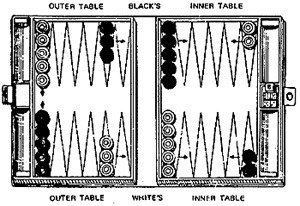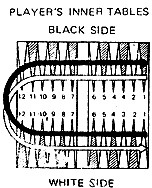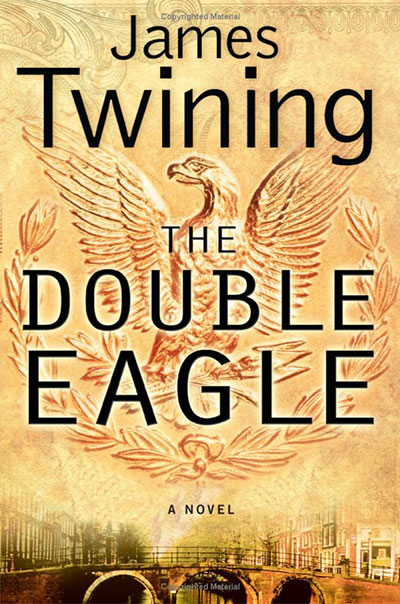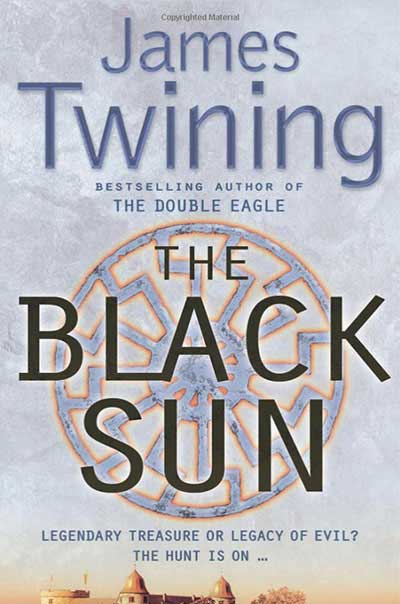Tom is something of an expert backgammon player and a key scene in The Double Eagle revolves around this. Below is a more detailed explanation of the history and rules of this unique game.
Brief History
Backgammon, or Shesh Besh as it is known throughout the Arabic world, is one of the world’s oldest board games. Its origins can be traced through the ancient Egyptian game of Senet, the Persian game Nard and possibly even the Indian game of Parcheesi. Its name is thought to have been derived in 1645 from the Saxon “baec” (back) and “gamen” (game).
The current form of the game emerged in England in the mid seventeenth century, although it wasn’t until 1743 that Edmond Hoyle codified the rules of play in his Treatise on Backgammon, the first official set of modern rules in existence.
The Board

Backgammon is a game of chance and skill for two players played on a board of twenty-four narrow dagger-like triangles of alternating colours (often red and white) called points. The board is divided in half by a centre partition called the bar which effectively splits the board into four quadrants. The two quadrants nearest to you are your outer and inner tables while the quadrants furthest away are your opponent’s outer and inner tables.
Getting started
Each player receives fifteen playing pieces, often called “stones” or “men”, of opposite colours, which are placed on the game board in a special opening formation (as shown in the illustration above).
The two players sit opposite each other and the goal is to be the first to move all your pieces into your inner table, then to remove them from the board. Both players roll one die and the person with the higher number starts.
Moving the pieces

Stones are moved based on the roll of two dice, with each player taking turns casting the dice and moving his pieces. You may apply each die to a separate piece, or the total may be used with one piece.
When only one number can be played, the player must play that number. If either number can be played, but not both, a player must play the larger one. When either number can’t be used, a player loses his turn. In the case of doubles (see below), when all four numbers can’t be played, a player must play as many numbers as he can
Doubles
If you roll a double, you get twice the points. That is, if you roll a double 6, you can move four pieces 6 places, two pieces 12 places, one piece 24 places etc.
Hitting and Entering
If your opponent has more than one piece on a particular point, then you can’t move there. However, if your opponent has only one piece on a point and you land on it, not only can you take the point away from him, but you also get to knock him off the board, and onto the “bar”.
Once a player has any pieces on the bar, he can’t move any of his other pieces until he gets off the bar and into the opposing home board. A stone is entered by moving it to an open point corresponding to one of the numbers on the rolled dice. For example, if a player rolls 4 and 6, he may enter a stone onto either the opponent’s four point or six point, so long as the prospective point is not occupied by two or more of his opponent’s stones.
If neither of the points is open, the player loses his turn. If a player is able to enter some but not all of his stones, he must enter as many as he can and then forfeit the remainder of his turn. After the last of a player’s stones has been entered, any unused numbers on the dice must be played.
Bearing Off
Once a player has all of his pieces on his own inner board, he can begin removing them from the board (known as “bearing off”). This is done by rolling the dice. A roll of 3-4, for instance, allows you to remove a piece from both the 3 and 4 points (points are numbered starting with 1 at the inner-most position of the inner table).
If there is no stone on the point indicated by the roll, the player must make a legal move using a stone on a higher-numbered point. If there are no stones on higher-numbered points, the player can remove a stone from the highest point one of his stones sits on. A player is under no obligation to bear off if he can make an otherwise legal move. A player must have all of his active stones in his home board in order to bear off. If a stone is hit during the bear-off process, the player must bring that stone back to his home board before continuing to bear off.
The Doubling Cube
Backgammon is played for an agreed wager (or number of points in tournament play). During the course of the game, a player who feels he has a sufficient advantage may propose doubling the stakes using the “Doubling Cube”, a six sided “cube” numbered 2, 4, 8, 16, 32 and 64. This is a relatively modern innovation, developed in New York in the 1920s.
He may do this only at the start of his own turn and before he has rolled the dice. A player who is offered a double may refuse, in which case he concedes the game and pays the original wager. Otherwise, he must accept the double and play on for the new higher stakes.
A player who accepts a double becomes the owner of the cube and only he may make the next double. Subsequent doubles in the same game are called redoubles. If a player refuses a redouble, he must pay the wager that was at stake prior to the redouble. Otherwise, he becomes the new owner of the cube and the game continues at twice the previous stakes. Redoubles can increase up to 64 x the original wager.
Beavering
A player that is doubled may immediately redouble or “Beaver” and retain possession of the cube. The original doubler has the option of accepting or refusing as with a normal double.
Scoring
The player who first removes all their pieces from the board wins. If their opponent has not borne off any pieces at that stage, the game is worth double the stake. This is known as a “Gammon”. If their opponent has not borne off any pieces and still has some pieces remaining in their opponent’s inner board, the game is worth triple the stake. This is known as a “Backgammon”.
A quick word on tactics!
While Backgammon is partly a game of chance, the key to winning lies in understanding probability and possessing the ability to successfully bluff.
With two six-sided dice, the minimum roll is two, the maximum twelve. There is therefore a one in thirty five chance of hitting each of these, since there are six times six total possible outcomes.
Relating this to the game is crucial in allowing you to asses how likely you are both to be hit, or hit someone else, or see through a particular move. For example it is unwise to leave an uncovered stone seven points away from an opposing player because they will have a nearly one in five chance of hitting it, the highest odds in the game. However, leave it ten or four points away and those odds increase to one in eleven, a much more acceptable risk
The use of the doubling dice in the modern game creates a fascinating psychological element to the game. Knowing when to accept, reject or even double back (beaver) is as important as the positioning of your pieces. Matches can be won or lost against the flow of play with judicious use of the doubling dice.
Further Resources
The following site provides an excellent resource for Backgammon related books, equipment, software, communities, news, rules, tutorials etc.




